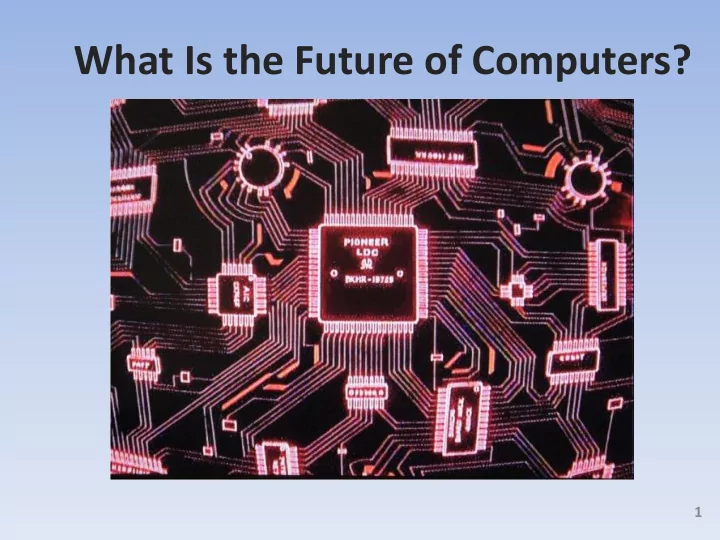

What Is the Future of Computers? 1
Introduction • Moore's Law states, that the number of transistors on a microprocessor double every 18 months. 2
Introduction • The year 2020 or 2030 will find the circuits on a microprocessor measured on an atomic scale. 3
Introduction • The logical next step will be to create quantum computers, which will harness the power of atoms and molecules to perform memory and processing tasks. 4
History • Quantum computing was first theorized in 1981 by Paul Benioff at the Argonne National Laboratory. • Benioff theorized about creating a quantum Turing machine. 5
Concept of quantum computing • Today's computers work by manipulating bits that exist in one of two states: a 0 or a 1. • On the machine level, this either/or dichotomy is represented using electrical circuits which can either be closed, in which case a current flows, or open, in which case there isn't a current. 6
Concept of quantum computing • Quantum computers aren't limited to two states; they works with particles that can be in superposition. • Rather than representing bits — such particles would represent qubits , which can take on the value 0, or 1, or both simultaneously. 7
Concept of quantum computing • This superposition of qubits is what gives quantum computers their inherent parallelism. • This parallelism allows a quantum computer to work on a million computations at once, while desktop PC works on one. 8
Implementation • Scientists have already built basic quantum computers that can perform certain calculations. 9
Implementation • At a NASA lab in Silicon Valley, Google is testing a D- Wave 2X quantum computer. 10
Quantum computing and cryptography • In public-key cryptography, data is secured by math problems that are easy to solve, but hard to reverse engineer. • While it is easy for a computer to multiply two prime numbers to produce a larger integer. 11
Quantum computing and cryptography • It takes an impractically long time on a computer to factorize a large enough integer into its component primes. 12
Quantum computing and cryptography • In a crypto scheme based on prime factorization, the primes serve as a person’s “private key,” which is not shared. • The product of the primes serves as the “public key,” which is distributed publicly. • When someone else uses the public key to encrypt a message, only the person in possession of the private key can decrypt it. 13
Quantum computing and cryptography • Widely used today RSA and the Diffie-Hellman key exchange based on this principle. 14
Quantum computing and cryptography • RSA(Rivest-Shamir-Adleman) algorithm is used in browsers which need to establish a secure connection. • Every time you visit a website with a URL that begins “HTTPS,” that algorithm is used. 15
What Is the Future of Computers? • A quantum computer could efficiently find prime factors for large integers. 16
Quantum computing and cryptography • This ability would allow a quantum computer to decrypt many of the cryptographic systems in use today. 17
Conclusion • Quantum computing is still in early stages of development. But quantum computers will replace silicon chips in the future, just like the transistor once replaced the vacuum tube. 18
Recommend
More recommend